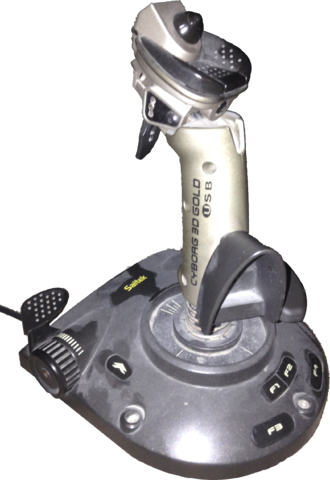Joystick
Joystick
A joystick is an input device consisting of a stick that pivots on a base and reports its angle or direction to the device it is controlling. Joysticks are often used to control video games but are also used in industry for controlling machinery such as cranes, trucks, and underwater unmanned vehicles.
History
The origins of the joystick can be traced back to the early 20th century, with its initial use in the aviation industry. The first known example was used to control an aircraft in the 1910s. Since then, the joystick has evolved significantly, with its application expanding beyond aviation to various fields including gaming, industrial control, and robotics.
Design and Function
A typical joystick consists of a handle that can be moved in multiple directions and buttons that can be pressed to perform actions. The movement of the joystick handle changes the electrical signals sent to the device it controls. These signals are then translated into actions, such as moving a character in a game or adjusting the position of a camera.
The design of a joystick can vary significantly depending on its intended use. For example, a joystick designed for flight simulation games may include features such as throttle control and multiple buttons for different functions, mimicking the controls found in an actual aircraft cockpit.
Types of Joysticks
There are several types of joysticks, including:
- Digital Joysticks: These joysticks send discrete on/off signals for each direction, making them suitable for simple applications.
- Analog Joysticks: Analog joysticks provide continuous input based on the position of the stick, offering more precise control.
- Hall Effect Joysticks: These use magnetic fields to detect the position of the stick, providing high accuracy and reliability.
- Force Feedback Joysticks: Also known as haptic joysticks, these can simulate forces, adding a tactile dimension to the user experience.
Applications
Joysticks are used in a wide range of applications, from controlling characters in video games to maneuvering industrial equipment. In the gaming industry, joysticks are an essential component of many control systems, particularly in flight and racing simulators. In industrial settings, joysticks are used to control machinery such as cranes and robotic arms, where precision and reliability are critical.
Future of Joysticks
With advancements in technology, the functionality and application of joysticks continue to expand. Developments in haptic feedback, wireless connectivity, and motion sensing are enhancing the user experience, making joysticks more intuitive and immersive. As virtual reality and augmented reality technologies continue to evolve, the role of joysticks as a bridge between humans and machines is expected to grow even further.
Transform your life with W8MD's budget GLP-1 injections from $125.
W8MD offers a medical weight loss program to lose weight in Philadelphia. Our physician-supervised medical weight loss provides:
- Most insurances accepted or discounted self-pay rates. We will obtain insurance prior authorizations if needed.
- Generic GLP1 weight loss injections from $125 for the starting dose.
- Also offer prescription weight loss medications including Phentermine, Qsymia, Diethylpropion, Contrave etc.
NYC weight loss doctor appointments
Start your NYC weight loss journey today at our NYC medical weight loss and Philadelphia medical weight loss clinics.
- Call 718-946-5500 to lose weight in NYC or for medical weight loss in Philadelphia 215-676-2334.
- Tags:NYC medical weight loss, Philadelphia lose weight Zepbound NYC, Budget GLP1 weight loss injections, Wegovy Philadelphia, Wegovy NYC, Philadelphia medical weight loss, Brookly weight loss and Wegovy NYC
|
WikiMD's Wellness Encyclopedia |
| Let Food Be Thy Medicine Medicine Thy Food - Hippocrates |
Medical Disclaimer: WikiMD is not a substitute for professional medical advice. The information on WikiMD is provided as an information resource only, may be incorrect, outdated or misleading, and is not to be used or relied on for any diagnostic or treatment purposes. Please consult your health care provider before making any healthcare decisions or for guidance about a specific medical condition. WikiMD expressly disclaims responsibility, and shall have no liability, for any damages, loss, injury, or liability whatsoever suffered as a result of your reliance on the information contained in this site. By visiting this site you agree to the foregoing terms and conditions, which may from time to time be changed or supplemented by WikiMD. If you do not agree to the foregoing terms and conditions, you should not enter or use this site. See full disclaimer.
Credits:Most images are courtesy of Wikimedia commons, and templates, categories Wikipedia, licensed under CC BY SA or similar.
Contributors: Prab R. Tumpati, MD






